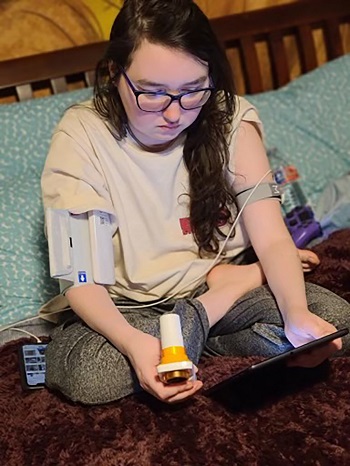 Kathlyn Chassey uses a home healthcare kit as part of the COVID-19 Remote Monitoring Program, a joint effort of the Virtual Medical Center and Brooke Army Medical Center, in San Antonio, Dec. 16, 2020. (Courtesy photo.)
Kathlyn Chassey uses a home healthcare kit as part of the COVID-19 Remote Monitoring Program, a joint effort of the Virtual Medical Center and Brooke Army Medical Center, in San Antonio, Dec. 16, 2020. (Courtesy photo.)
“Real-time data is compiled into a single dashboard where we can review all patients, grouped by risk,” Walter explained.
A team of teleworking nurses, located in the San Antonio, Texas, area, monitor patients across the eight participating military treatment facilities. Additionally, each site has on-call medical staff in case of an alert or patient concern. Each tablet has a button for assistance that initiates nurse engagement and, if needed, a HIPAA-compliant connection for face-to-face video evaluation with a nurse or on-call physician.
“I felt secure knowing the nurses were keeping an eye on me,” Chassey said. “One night I was having a nightmare. They texted me because my heart rate had increased and wanted to know if I was okay. It’s like being in the hospital, but in the comfort of your own home.”
After a patient no longer needs monitoring or requires a higher level of inpatient care, the patient receives prepaid shipping boxes to pack up the equipment and calls a courier for a contactless pickup. The company then sanitizes, services and repackages the kit for mailing back to the military treatment facility.
The idea for the program was spurred by lessons learned in New York last spring during the initial COVID-19 wave, Walter explained. “The hospitals were so busy; they were having to move patients through the continuum of care, from inpatient to outpatient, at a more rapid pace to accommodate incoming COVID-19 patients.”
Some of these patients were still symptomatic or had higher oxygen requirements, he said, but with new patients flowing in, the care teams were faced with tough decisions. To mitigate risk, some hospital systems established a program in which paramedics would check on patients in their home to ensure they weren’t declining or needing readmission.
“Reflecting on these experiences, we began to explore the idea of leveraging virtual health in the event we are faced with a COVID surge in the hospital and need to move patients more quickly through the facility,” Walter said. “If that happens, it becomes vital to retain capacity without compromising the safety or quality of care for our patients.”
With a global vs. local program in mind, Walter and Yourk approached the Defense Health Agency, which assisted in obtaining and funding 200 home kits that could satisfy the requirement of a “high fidelity of monitoring in an outpatient environment,” Walter said.
“It is truly incredible how the clinical leads from each military treatment facility and the Virtual Medical Center came together to take this pilot from a concept to reality in under six months to support beneficiaries from the East to West coast,” Yourk added.
With the ongoing threat of the pandemic and to preserve bed capacity, the program is mainly intended for COVID-19 patients at this time, but there is a much broader application potential, Walter noted.
“We are exploring the long-term benefit for a number of conditions that often require frequent admissions, such as congestive heart failure, chronic obstructive pulmonary disease, cystic fibrosis and asthma,” he said. “As with COVID patients, the system can alert us to issues, enabling us the ability to adjust a care plan or facilitate a more rapid assessment if someone’s condition worsens.”
An additional population is patients who come to the Emergency Department who may not meet admission criteria, but could still benefit from elevated care, he added. Further down the line, Yourk hopes the program can be expanded to deployed service members and pediatric patients.
In the meantime, Walter and Yourk are focused on ensuring each military treatment facility has the tools and support needed to successfully carry out this program, particularly as COVID rates increase across the nation. The program will roll out in a phased approach to gauge the efficacy of the system, Walter said, before expanding to additional military treatment facilities.
“We are truly at the leading edge,” he noted. “There are well-validated use cases for single-data monitoring platforms, such as for patients with specific medical conditions such as heart arrhythmia, but we’re helping break ground on a system that can monitor a number of different data points simultaneously for patients with varying diagnoses in the comfort of their home.”
The kits already have been disbursed to participating hospitals and 13 patients were enrolled in the first week, saving approximately 15 bed-days and improving the care delivered to patients, Yourk said.
Chassey said she’s now on the road to recovery, but is thankful for the safety net the remote patient monitoring pilot offered.
“I felt safer going home knowing that I had assistance standing by. I know, from experience, how quickly things can take a bad turn,” she said.
I wish I had something like this before my transplant,” she added. “I spent so much time in the hospital over the years and this type of technology would have given me more time at home.”
Walter said the program is mutually beneficial. “This program enables patients to return home sooner, be with family, while mitigating COVID risks to patients and staff,” he said. “It’s a game-changer for us as we continue to battle this pandemic.”